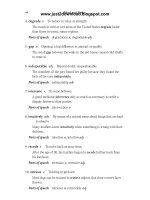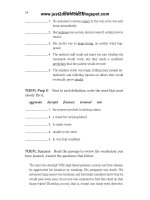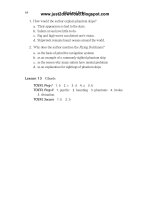Tài liệu Essential words for the toefl part 2 ppt
Bạn đang xem bản rút gọn của tài liệu. Xem và tải ngay bản đầy đủ của tài liệu tại đây (79.64 KB, 15 trang )
British - Words that are in common usage in British English
Regional - Words that are used in a limited geographical area
THE THESAURUS
A thesaurus is a collection of words with similar meanings, usually presented in alphabetical order.
These words are called synonyms. A thesaurus is useful when you want to change a word to another
word with a similar meaning. The entries in a thesaurus typically contain the synonyms in most
frequent to least frequent occurrence. In a modern thesaurus, guide words also appear at the tops of
pages. They function the same way as guide words in dictionaries, indicating the first and last words
of the pages. All words on the page appear in alphabetical order. Not all words have synonyms, yet
almost all words on the TOEFL are words with many synonyms. Therefore, regular use of a
thesaurus will build your vocabulary and help you prepare for the TOEFL.
Most of the same word labels used in dictionaries appear in a thesaurus. Many entries do not specify
the difference between adjective and adverb, since the same forms can often appear both as
adjectives or adverbs. The abbreviation mod. is used to mark such a word. Let's examine an entry
for the word maximum.
maximum, mod. -Syn. supreme, highest, greatest; see best 1. maximum, n.-Syn. supremacy, height,
pinnacle, preeminence, culmination, matchlessness, preponderance, apex, peak, greatest number,
highest degree, summit, nonpareil; see also climax: Ant. minimum*, foot, bottom.
There are two entries for this word. The abbreviation mod. in the first entry indicates that the word
could be used as a modifier of other words. Following this, syn. indicates that synonyms for the
word follow. At the end of the listing appears the suggestion see best 1. This suggestion refers us to
the first entry for the word best if we wish to see more words with meanings related to maximum.
The second entry gives the synonyms for the noun form of the word. The n. indicates that the word
is used as a noun, and syn. indicates that synonyms follow. This entry also refers the reader to the
word climax for additional words related to maximum. At the end of the entry, antonyms, marked
with the label ant., are listed.
The dictionary and thesaurus are two powerful learning tools that you should have for reference.
They are essential for a good vocabulary building program.
CHAPTER 6
THE ESSENTIAL TOEFL
VOCABULARY
This chapter contains 30 lessons. Each lesson contains entries for 15 key TOEFL words. After these
entries, there are 10 matching exercises. At the end of each lesson, there are five TOEFL -like
vocabulary questions that contain all of the words in each lesson. The TOEFL-like questions are an
excellent vocabulary review as well as thorough preparation for the vocabulary section of the
TOEFL.
You should study the lessons in order, For example, after studying lesson 1, go directly to lesson 2.
The book is designed to provide systematic review of words in previous lessons. By studying the
lessons out of order you will be defeating the purpose of the review system.
Let's examine a sample entry to see the kinds of information you will learn.
intricate
adj. having many parts; finely detailed
adv. intricately syn. complex
n. intricacy
The intricate design of the vase made it a valuable piece for her collection.
I cannot begin to understand all of the intricacies of modern automobile motors.
The entry features the word intricate. Directly under the word, you will find other forms of the same
word. These words have the same general meaning; they represent the different parts of speech of
the word. For each of the forms, the part of speech is given. The following abbreviations for parts of
speech are used in the word entries.
adj.
)
adjective
adv.
)
adverb
conj.
)
conjunction
v.
)
verb
n.
)
noun
In the case of intricate, the adjective form, adj., is presented as the key word. Other forms of the
entry, intricately and intricacy, are listed below the main entry.
The key word is then defined in clear, easy to understand English. In this example, we see that
intricate means something having many parts or something that is finely detailed.
Under the definition you will find a synonym for the key word. The synonym is a word that has the
same or a similar meaning and it is marked with the letters syn. In the example above, the synonym
given for intricate is complex.
Below the synonym, there are two sentences that show the usage of two different forms of the word.
The sentences are rich in context; that is, the words surrounding the key word tend to support and
clarify the meaning of the key word. Let's look at the two sentences in the example.
The intricate design of the vase made it a valuable piece for her collection.
I cannot begin to understand all of the intricacies of modern automobile motors.
The key word will always appear in the first sentence. The key word sentence is followed by a
second sentence illustrating the use of one of the related words, but with a different part of speech.
If no related words are given, then the second sentence serves as another illustration of the meaning
of the key word.
Some word forms are not included in the entries. These are words that are not in common usage and
not likely to appear on the TOEFL.
The word entries provide you with all the information you need to build a powerful TOEFL
vocabulary.
STUDYING THE WORD ENTRIES
In order to study vocabulary efficiently, you must have a study plan and follow it carefully. The
following plan has been useful to many students who are building their TOEFL vocabulary.
Plan to spend at least an hour studying the words in each lesson of this book. Do not study words
that you already know.
Read
First, read the 15 entries of the lesson carefully, including the definition, different forms, synonym,
and example sentences. It is important for you to associate the key word with its meaning and
synonym. These are the three most important parts of the word entry.
Reread
Next, read each word entry again. Look up unfamiliar words that appear in the example sentences.
This time when you study the entry, cover the key word, then look at the meaning and its synonym.
Then identify the key word. When you are able to identify the key word, reverse the process by
identifying the covered synonym. Finally, cover everything in the entry, except the meaning, and
identify the key word and its synonym.
Find the Synonyms
You are now ready for the matching exercise at the end of the word list. Let's look at a typical
matching question.
1. intricate
(A) functional
(B) complex
(C) predominant
(D) inordinate
The purpose of the question is to test your knowledge of synonyms, a key skill for the TOEFL. You
will see four choices. In this example, you must choose the synonym for the word intricate. The
correct answer is , complex. Nearly all the words that appear as answer choices are key words
introduced in the same and previous lessons. Check your answers by referring to the Answer Key at
the back of this book.
You are now ready to test your skill on actual TOEFL-like questions. Let's look at the following test
question.
The intricate design of the building's facade is typical of buildings of the nineteenth century.
(A) functional
(B) accurate
(C) standard
(D) complex
This test question is typical of the questions on the vocabulary section of the TOEFL. You must
choose the word that has the same or similar meaning as the underlined word in the sentence. Most
TOEFL, questions do not use the word in a sentence context that will help you with word meaning.
Therefore, as we learned in Chapter 2, you will probably not be able to determine the meaning of
the word by reading the sentence. Look directly at the underlined word and do not read the
sentence. Look for its synonym among the four choices. The correct answer is , complex. Most of
the answer choices for the test questions at the end of each lesson are key words introduced in that
lesson.
Make Flash Cards
After you have studied the 15 words and their synonyms, and have completed the practice
exercises, make flash cards. On one side of the card, write the key word and its related forms. On
the other side of the card, write its synonym. Review these cards several times during the weeks
before your TOEFL test session. If you are preparing for a specific TOEFL test date, make a study
schedule based on how much time you have before the TOEFL. For example, if you have six weeks
before your test date, plan to study five lessons each week.
Be sure that you organize your cards. It is suggested that you organize your cards by alphabetical
order of the synonyms or by the lesson number. Keep two groups of cards: one group for the words
you have learned, and the second group for those words you need to learn. Re-view the second
group more often than the first group of words that you already know.
As your vocabulary grows, return to the exercises and test questions in each lesson.
By following this study plan you will be better prepared for the important day when you hear the
words You may now open your TOEFL test booklet ".
Now begin Lesson 1 following the directions you have just read.
CHAPTER 7
THE PRACTICE TESTS
GENERAL DIRECTIONS
Essential Words for the TOEFL provides you with two TOEFL Vocabulary Practice Tests on the
pages that follow. After you have studied the vocabulary lessons in this book, take both of the tests
on separate days.
When taking each test, circle the correct answer in your book. Allow yourself no more than 15
minutes to take each test. Although on an official TOEFL you will be given 45 minutes to complete
Section 3 of the test, you should complete the vocabulary items in less than 15 minutes, in order to
give yourself ample time to answer the longer Reading Comprehension items. Thus, allow yourself
no more than 15 minutes to complete each of the Practice Tests that follow.
After you take each test, score it using the answer key provided on page 197 of this book. For each
item you answer incorrectly, look up the word tested in this book. Try to understand why you made
the mistake so you won't make it again. If necessary, look up the tested word or the options in your
English dictionary. This will provide you with additional information on the meaning of the word in
different contexts and perhaps other ex-ample sentences demonstrating its usage.
For information on interpreting your performance and converting it to the TOEFL scale, follow the
directions in Scoring Your TOEFL Vocabulary Practice Tests, at the end of this Chapter. Now take
the TOEFL Vocabulary Practice Test 1.
TOEFL VOCABULARY PRACTICE TEST 1
1. It is evident that animals played a predominant role in the world of the upper Paleolithic
Period.
(A) hazardous
(B) principal
(C) minuscule
(D) misunderstood
2. Some experts believe that the functions of the print media will be replaced by audio or visual
media.
(A) distribution
(B) influences
(C) roles
(D) popularity
3. A central issue in probability is predicting the value of a future observation.
(A) recording
(B) interpreting
(C) observing
(D) foretelling
4. The modem world is inundated with competing propaganda and counterpropaganda.
(A) balanced
(B) sustained
(C) overwhelmed
(D) contaminated
5. The expansion of public services has caused concern that the civil service branches are
becoming autonomous powers.
(A) independent
(B) advanced
(C) superior
(D) perilous
6. A deep rock tunnel between Washington, D.C. and Boston that employs an entirely new type
of rapid conveyance is receiving serious consideration from civil planners.
(A) an outlandishly
(B) a comparatively
(C) an intrinsically
(D) a completely
7. Women's magazines reflect the changing view of women's role in society.
(A) distort
(B) show
(C) accentuate
(D) promote
8. Courtship is a widespread prelude to mating among modern reptiles.
(A) a tedious
(B) an uncontrolled
(C) a common
(D) an essential
9. The elimination of carbon dioxide is a necessary process in all animals.
(A) rejection
(B) accumulation
(C) deletion
(D) production
10. In contrast to traditional rhetoric, modern rhetoric has shifted its focus to the audience or









